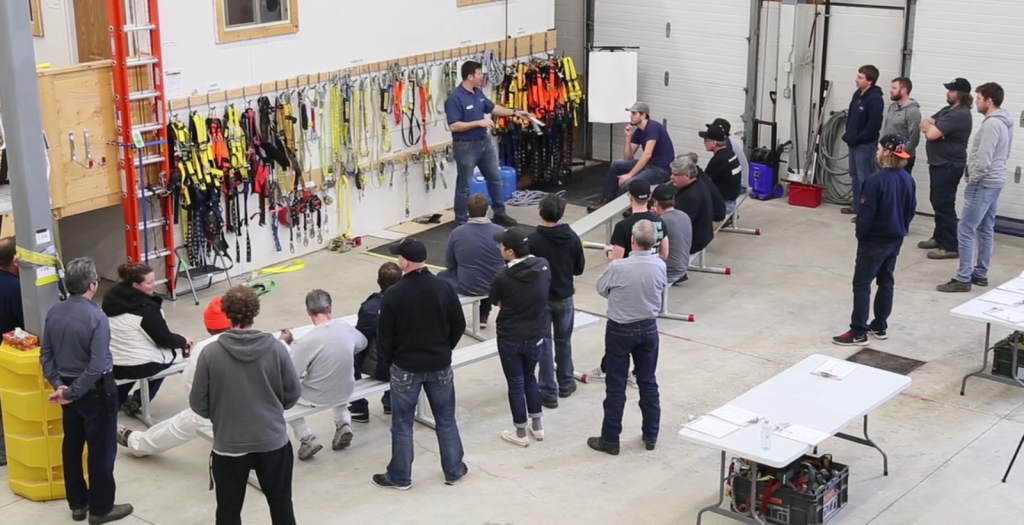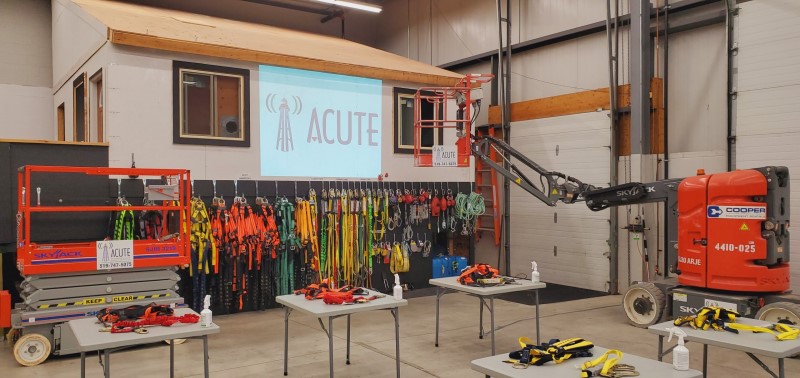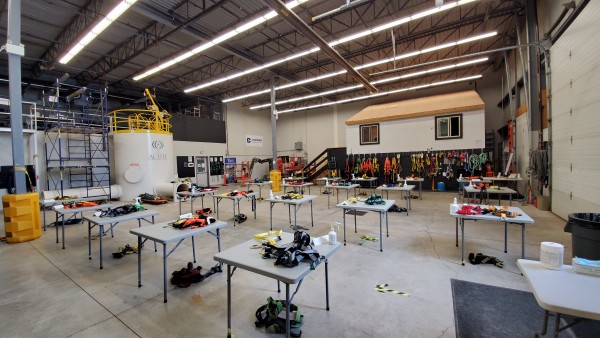Here are the basic laws and regulations that surround working at heights training in Ontario:
1. Ontario requires that anyone working on a construction project who uses fall protection equipment must take working at heights training. Learn more.
2. Your employer is responsible to get a record of training from your working at heights training provider. Learn more
3. A thorough working at heights training program will include both a theory component and a practical component. Learn more
4. Working at heights training is good for 3 years from the date you complete an approved training program delivered by an approved training provider. Learn more

Working at heights training is necessary if you use fall protection equipment on a construction project
Working at Heights Training
1. Is Working at Heights Training Mandatory In Ontario?
Yes. Ontario requires that anyone working on a construction project who uses fall protection equipment must take working at heights training. Here is the criteria for your training as set out by the Ontario government:
- Your training must be approved by the Ministry of Labour, Immigration, Training and Skills Development’s Chief Prevention Officer
- Your training needs to be delivered by a training provider who has been approved by the Chief Prevention Officer
- Your training needs to be completed before you can use fall protection
Working at heights training requirements are set out in O. Reg. 297/13: Occupational Health and Safety Awareness Training.
Specific Requirements for Working at Heights Training in Ontario
According to O. Reg. 213/91: Construction Projects you will need to take working at heights training if you work on a construction project that is covered by O. Reg. 213/91 and you need to use any of the following fall protection methods:
- Travel restraint system
- Fall restricting system
- Fall arrest system
- Safety net
- Work belt
- Safety belt
There are, however, limited exemptions if you are a worker who is directly employed by an automobile manufacturer or assembler.

Working at heights training requirements are set out by the Ontario government – Image taken before COVID-19
2. Do You Need to Keep a Record of Your Working at Heights Training?
Yes. According to O. Reg. 213/91: Construction Projects. Your employer is responsible to get a record of training from your working at heights training provider. This record must:
- Be a written training and instruction record
- Be signed by the training provider
- Include the worker’s name and the dates that the training was taken
- Be made available if an inspector requests to see it

You need to keep a written record of your training – Image taken before COVID-19
3. What Do You Do at Working at Heights Training?
A thorough working at heights training program will include both a theory component and a practical component. For example, if you take your training at ACUTE, you will learn the following:
Working at Heights Theory
This component will take 3 hours and will cover the following topics:
- Working at heights [WAH] and legislation
- WAH hazards
- Safe work plans & assessing and controlling WAH hazards
- The hierarchy of controls – application to WAH
- Fall prevention strategies and systems
- Fall protection systems
- Ladder safety
You will be given a written evaluation to ensure that you fully understand everything that you have learned.
ACUTE offers both a theory and a practical component to your working at heights training
Working at Heights Practical Component
The practical portion of the ACUTE training course will give you the necessary experience using the techniques that you learned in the theory module. This session will last 3.5 hours and will include:
- Fall prevention/protection system requirements and limitations
- A-B-C component selection, inspection and use
- Harness inspection, fitting exercise and evaluation
- Lanyard inspection exercise and evaluation
- Travel restraint, fall arrest set-up exercise and evaluation
- 100% tie-off exercise and evaluation
- Ladders, scaffolds and elevating work platforms
- Rescue plan – components and purpose
- Safe work strategies and safe anchor exercise
You will also be given a written evaluation at the end of this module to ensure that you have learned everything you have been taught.
Learning Methods
During both modules in the ACUTE working at heights training program, you will be taught using a variety of different learning methods. Having a variety of techniques will give you a well-rounded experience and will help you with retention. For example, you will learn by:
- Classroom interaction with experienced instructors
- Tabletop scenarios and hands-on exercises
- Demonstration and hands-on training in the care and use of equipment
- Detailed handouts, videos and quizzes
- Practical performance evaluations

ACUTE uses a variety of learning methods in their working at heights training
ACUTE’s Training Facility
You can choose to either take your Working at Heights training at our world-class facility, or if you prefer, we can come to your site. Our training facility features:
- Industry standard health and safety equipment and technologies
- Simulation areas for a full suite of training programs (i.e. working at heights, confined space, and hazardous materials)
- Classroom facilities for lecture and technical training delivery
- Human dummies for confined space rescue and hazardous material controls
4. How Long Is Working at Heights Training Good For?
Working at heights training is good for 3 years from the date you complete an approved training program delivered by an approved training provider. A Working At Heights Refresher course must be taken every 3 years in order for you to remain compliant.
Get Your Working at Heights Training From Acute
You can trust ACUTE for the best safety training possible, including working at heights training. ACUTE’s experienced team members have been serving safety professionals for over 20 years. You can rely on ACUTE for hands-on, physically distanced, practical safety training to keep your employees safe in the workplace. ACUTE is dedicated to workplace safety and understands the importance of course and training provider approval. Why get workplace safety training with ACUTE? Here are just some of the benefits of working with ACUTE:

- Open Door Instructor-Student Partnership – ACUTE’s training services emphasize client participation. Staff foster relationships with clients and serve as a touchstone for advice anytime moving forward.
- Serving Your Team and Industry – With a vast array of clients in the manufacturing, construction, health, academic, and government sectors, ACUTE brings the best safety practices from across the spectrum to your workplace.
- 100 Years Combined Experience – ACUTE provides comprehensive health and safety training, on-site safety services, and consulting services. With over 100 years of combined experience, our company staff offer more than theoretical or abstract ideas. ACUTE offers solutions.
- Track Record of Success – ACUTE is rated 4.9/5 stars on Google reviews, demonstrating a commitment to our clients, quality, and passion for training.
Check out our course calendar for times and dates of our courses.
What Our Customers Are Saying…
“I work at the University of Guelph as an arborist. Ron Campbell provided a small socially distanced group and myself with working at heights training. Ron has a wealth of knowledge and kept everyone engaged with many “real life” examples of working at heights scenarios and facts. We have also received elevated work platform training with Patrick from Acute training. Patrick is also a very friendly, knowledgeable and engaging professional trainer. I truly believe that the best trainers are those with practical experience and the trainers at Acute have that locked down.”

